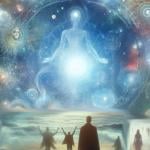Since pages 1 through 6 are missing from the Gospel of Mary, our fragmented text begins with a question posed to Jesus near the end of what we might call Chapter 2 on page 7.
Starting here, we notice that even this is a fragment with only the last few sentences remaining at the end.
This chapter begins, and ends with the question and response:
“Will matter then be destroyed or not?” [someone asks] The Savior said, “All natures, all forms, all creatures exist in and with one another, and they will be resolved again into their own roots. For the nature of matter is released into the roots of its nature. Those who have ears to heart, let them hear!”
Scholars seem to agree that this conversation takes place between Jesus and his disciples sometime after the resurrection.
Having recovered from their initial shock and surprise at discovering Jesus alive again, the disciples have turned to questioning the resurrected Christ about the nature of matter, the end of the world, and, of course, sin. His responses are somewhat surprising, especially to those who have already made assumptions about these topics.
In this case, when asked about the possible destruction of material things, Jesus declares that matter and energy are eternal and cannot be destroyed.
This ancient wisdom echoes the Law of Conservation of Mass – developed in 1789 by French chemist Antoine Lavoisier – which states that matter cannot be destroyed but can only change form through physical or chemical reactions. Albert Einstein’s famous equation, E=mc², further develops this concept with the theory of relativity which showed that matter can be converted to energy, and vice versa, but never truly destroyed.
So, Jesus somehow knew what both Lavoisier and Einstein discovered without mathematical formulas or an understanding of modern physics nearly 2,000 years in advance. That’s quite an impressive opening response from the Nazarene carpenter.
Additionally, Jesus seems to understand what later Quantum Physicists would discover: that all matter is interwoven with everything else.
When he says, “All natures, all forms, all creatures exist in and with one another…” he’s referring to the interconnectedness of the Universe. Later physicists would express it like this: “The Quantum Field is everything, and everything is the Quantum Field.”
In other words, everyone and everything is connected to everyone and everything else.
There is no separation. Not between individual molecules or atoms. Not between stars and planets. Not between you and me. Not between God and Creation.
All is one and one is all. Separation is an illusion. We are all part of one another. We are all connected to everything and everything is connected to all of us.
For many Christians, this poses a very real problem: If we are not separated from God, and if such a thing isn’t even logically possible, then what about our sin? Doesn’t sin separate us from God? If not, then why do we need a savior? Why did Jesus have to die?
These questions are now swirling around inside every disciples head, but of course, Peter is the first one to blurt it out.
That’s what we’ll cover in the next chapter.
[1] The Gospel of Mary Magdala: Jesus and the First Woman Apostle, Karen King, pg. 3
**

The newest book from Keith Giles, “The Quantum Sayings of Jesus: Decoding the Lost Gospel of Thomas” is available now on Amazon. Order HERE>
Keith Giles is the best-selling author of the Jesus Un series. He has appeared on CNN, USA Today, BuzzFeed, and John Fugelsang’s “Tell Me Everything.”
He co-hosts The Heretic Happy Hour Podcast and his solo podcast, Second Cup With Keith which are both available on Spotify, Amazon, Apple, Podbean or wherever you find your podcast fix.















